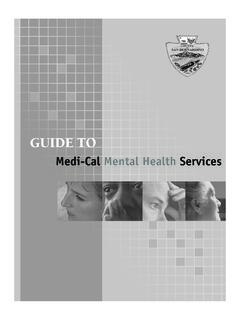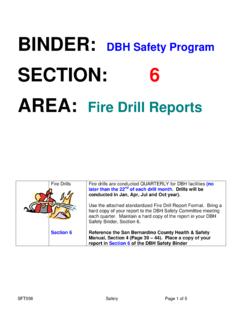Transcription of Community Crisis Services - San Bernardino County
1 Service GoalsService Goals The objectives of Community Crisis Services are: Reduce incidents of acute involuntary psychiatric hospitalization Reduce the amount of calls to law enforcement for psychiatric emergencies Reduce the number of psychiatric emergencies in hospital emergency departments Reduce the number of consumers seeking emergency psychiatric Services form hospital emergency departments Reduce the amount of time a patient with a psychiatric emergency spends in hospital emergency departments Increase consumer access to Services County of San Bernardino Community Crisis Services Community Crisis Response Team and Crisis Walk-in Centers Revised Mental Health Services Act Dollars Mental Health Services Act Dollars Working in the Community !Working in the Community ! Outlying areas of the largest geographic County in the contiguous United States had no alternatives for mental health crises other than hospital emergency departments or calls to law enforcement to place a person in Crisis on a psychiatric hold.
2 Law Enforcement personnel would spend 4 to 8 hours on psychiatric emergencies, delaying an officer s return to the Community due to transporting mental health consumers to a hospital, up to 200 miles away. Hospitalization occurred in psychiatric hospitals miles from family and support systems. Community members from all walks of life were ending up in an emergency room, because they didn t know where else to go, resulting in hospital emergency department overload. A person experiencing a psychiatric emergency was often in an inappropriate service location, such as, emergency rooms, law enforcement agencies, correctional facilities and homeless shelters. The Department of Behavioral Health s (DBH) Community Crisis Services (CCS) has increased resources and access to Services for mentally ill Community members in Crisis . By providing these Services individuals are helped in Community settings with an appropriate level of care, thus avoiding unnecessary hospitalization.
3 Collaboration among High Desert Law Enforcement, Adult Protective Services , Department of Aging and Adult Services , Children and Family Services and Transitional Age Youth Program helped to establish a Crisis system of care for the High Desert region. July 2011: The Countywide Hospital Collaborative was started to work on system wide solutions for impacted First Responder Systems that service mentally ill clients in Crisis . DBH contracted with Telecare to open a Crisis Walk-In Center (CWIC) in the Morongo Basin area. Fiscal Year 2010 2011: The Community Crisis Response Team ( ccrt ) received 7,275 calls. Of those,4,158 were Crisis calls, which ccrt responded to. ccrt was successful in diverting 2,336 consumers from inappropriate hospitalization and linking them to a more appropriate level of care. Multiplying the number diverted from hospitalization (2336), the daily bed rate ($550) for one day of inpatient care, results in $1,284,800 in avoided costs.
4 ccrt responded to 894 calls from law enforcement and 2,225 calls from hospital emergency departments; the response provided the necessary Services to avoid unnecessary hospitalization and incarceration. CWICs provided Services to 7,530 clients in Crisis . Of those who received Services at the CWICs 7,131 were diverted from inappropriate hospitalizations and incarceration. Multiplying the number diverted from hospitalization (7131), the daily bed rate ($550) for one day of inpatient care, results in $3,922,050 in avoided costs. Law enforcement agencies brought 506 individuals to CWICs and local hospitals referred 232 individuals for psychiatric Services at the CWICs, greatly reducing the number of unnecessary hospitalizations and incarcerations. Positive Results Positive Results Program DataProgram Data Making A DifferenceMaking A Difference Just prior to the holiday season, ccrt was called to a local High school to provide Crisis Services following the suicide of a high school student.
5 ccrt met with a group of students three times and discussed what to do if they or a friend needed help. Four months later, one of those students who had taken a ccrt Crisis card, called ccrt and reported that a friend s "My Space" page had suicidal statements on it. ccrt obtained the statements and the student s address from the caller. ccrt determined that an extreme risk was evident and called local law enforcement. ccrt met law enforcement officials at the student's home and assessed the student s risk of danger to self. The student was voluntarily hospitalized with the support of their parents. 95% 5% 56% 44% Community Crisis Services (CCS) currently faces challenges with the County of San Bernardino s large geographical area for acceptable response times. This County also has diverse cultural communities that range from urban to desert to mountains.
6 The desert regions lack of psychiatric hospitals and long distances from supportive Services continues to be a challenge for CCS. The increased need for mental health Services coupled with decreased health coverage and Services has led to an increase in acute psychiatric emergencies. ChallengesChallenges Solutions in ProgressSolutions in Progress For information regarding Services please call: ACCESS UNIT (888) 743-1478 or (888) 743-1481 (TTY) Dial 2-1-1 to get information and referrals for health and social Services . Get connected with a live operator 24 hours a day, 7 days a week. CCS first began with 8 staff providing mobile response for children only. The Community Crisis Response Team now has: Expanded to all regions of the County Includes adult Services Operates 24/7 for all age groups Opened two additional CWICs, one in the High Desert and one in the Morongo Basin Opened a CWIC to serve the urban population of the inland valleys CCS works closely with the Crisis Intervention Training (CIT) in partnership with the Sheriff s Academy.
7 CIT: Provides law enforcement with skills to work with mentally ill individuals Officially began in June of 2008, 13 classes have been held, resulting in 370 deputies/officers being trained Provided a 32-hour Crisis Intervention Training to 93% of law enforcement personnel in the high desert Has enabled law enforcement to stay in the Community Allows the mental health professionals to offer the right service, at the right time, at the right place Today the Community Crisis Services System of Care consists of the Community Crisis Response Teams and the Crisis Walk in Clinics. Through collaborative efforts with the County of San Bernardino Sheriff s Office, local hospitals, County and Community based agencies, a psychiatric emergency system of care has been developed that has reduced the burden on the first responder system and most importantly delivered appropriate Services to citizens within their Community .
8 Awards & Recognition 2007 National Association of Counties Achievement Award - Best in Class for Children s Crisis Response Team 2010 National Association of Counties Achievement Award for Crisis Walk-In Centers 2010 Harvard Kennedy School of Government Bright Idea Award For Community Crisis Service. The Community Crisis Response Team is a God Send -Lt. Dale Mondary
















